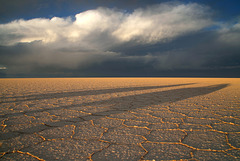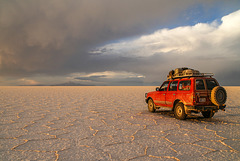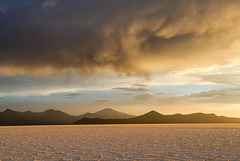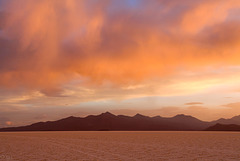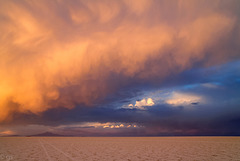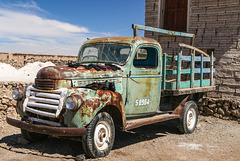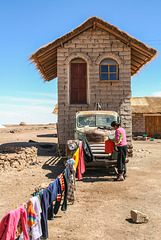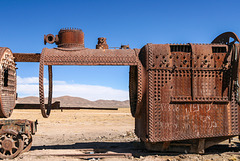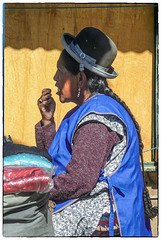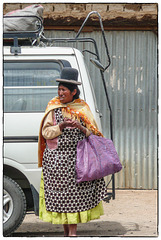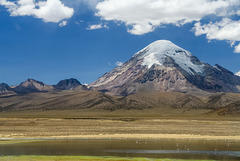
Bolivia
Folder: Latin America
Salar de Uyuni
Salar de Uyuni
| |
|
|
|
The world's largest salt flat covers 10.582 km², is 3656m above sea level and contains approximately 50-70% of the world's lithium reserves in the brine under the salt crust.
en.wikipedia.org/wiki/Salar_de_Uyuni
Clickable note
After the storm
| |
|
|
|
Salar de Uyuni at the end of the dry season. In "Bolivian winter" (actually summer!) the Salar is covered by water which makes it dangerous to drive on.
en.wikipedia.org/wiki/Salar_de_Uyuni
Sunset on Salar de Uyuni
Sky on fire
| |
|
|
|
Stormclouds over Salar de Uyuni turning colourful at sunset
See inset photo www.ipernity.com/doc/523247/28834717
Sunset on the Salar (PiP)
| |
|
|
|
Sunset clouds over Salar de Uyuni with Volcán Tunapa in the distance. We had a toast with Bolivian wine for the occasion, but the first drop goes to Pachamama as an offering - the ritual is called ch'alla (see inset photo)
Isla Incahuasi (view full size!)
| |
|
|
|
View from the top of Isla Incahuasi over Salar de Uyuni. The distant mountain is Volcán Tunupa.
Salar de Uyuni lies at 3660m and is the world's largest salt flat at 10.582 km². 30.000-42.000 years ago Salar de Uyuni was part of prehistoric Lake Minchin which slowly evaporated and left the Salar along with Lake Titicaca, Lago Poopó and Salar de Coipasa. Salar de Uyuni is covered with a salt crust of up to 30m thickness, underneath is a brine saturated with sodium chloride, lithium chloride, and magnesium chloride. Salar de Uyuni holds 43% of the world's lithium reserves.
Isla Incahuasi and the other "islands" are the tops of ancient volcanoes submerged during the era of Lake Minchin. They are covered by fossilized coral and stromatolites, giant cacti (trichocereus pasacana) grow on the islands.
en.wikipedia.org/wiki/Salar_de_Uyuni
Salar de Uyuni liegt auf 3660m Höhe und ist mit 10.582 km² der weltgrößte Salzsee. Er entstand vor ca. 30.000-42.000 Jahren aus dem prähistorischen Minchin-See, der langsam verdunstete und den Titcacasee, den Lago Poopó sowie Salar de Coipasa und Salar de Uyuni zurückließ.
Der Salar ist mit einer bis zu 30m dicken Salzschicht bedeckt, unter der sich eine in Wasser gesättigte Lösung von Sodiumchlorid, Lithuíumchlorid und Magnesiumchlorid befindet. Unter dem Salar de Uyuni finden sich 43% der weltweiten Lithiumvorkommen.
Isla Incahuasi und die anderen "Inseln" im Salar sind die Gipfel alter Vulkane, die vom Minchin - See überflutet wurden. Sie sind mit versteinerten Korallen und Stromatoliten bedeckt und mit riesigen Kakteen (trichocereus pasacana) bewachsen.
de.wikipedia.org/wiki/Salar_de_Uyuni (der englische Wiki-Artikel ist deutlich besser)
Planet Incahuasi (PiP)
| |
|
|
|
My first try at a little planet, inset the panorama it was made from. Shot from the top of Isla Incahuasi, an island in the middle of Uyuni salt flats.
www.photographymad.com/pages/view/little-planet-photos-5-simple-steps-to-making-panorama-worlds
Mein erster "Planeten"-Versuch, das Ursprungs-Panorama ist im PiP. Aufgenommen vom höchsten Punkt der Isla Incahuasi im Uyuni-Salzsee.
Battered, but still running (PiP)
Veteran
Washing day
| |
|
|
|
A newly built salt storehouse (still lacking the stairs to the door) and a veteran truck used for drying laundry. See inset photos!
Cementerio de Trenes
| |
|
|
|
In the late 19th century Uyuni used to be a train hub with railway lines to ports on the pacific coast, mostly for freight trains carrying minerals. Construction was planned and supervised by British engineers invited by the Antofagasta and Bolivia Railway companies. In the 1940s the lines fell into disuse and after the valuable copper parts were removed the locomotives were left to rust.
Abandoned
| |
|
|
|
In the late 19th century Uyuni used to be a train hub with railway lines to ports on the pacific coast, mostly for freight trains carrying minerals. Construction was planned and supervised by British engineers invited by the Antofagasta and Bolivia Railway companies. In the 1940s the lines fell into disuse and after the valuable copper parts were removed the locomotives were left to rust.
Altiplano fashion
| |
|
|
|
NOT the Sunday Challenge:
Aymara woman at a market stall in Oruro. The bowler hats are always worn a size too small;-)
Cholita (PiP)
| |
|
|
|
Seen in Patacamaya: Aymara woman going to market, inset more hat fashions;-)
de.wikipedia.org/wiki/Cholita
The rise of the Cholita
Carniceria buena
Sh*t happens
| |
|
|
|
Accident at the foot of Bolivia's highest mountain, Nevado Sajama (6542m).
Since Bolivia lost the province of Antofagasta and its access to the sea in the late 19th century Guerra del Pacífico, most freight goes from La Paz along Ruta 4 to the border at Tambo Quemado/ Chungará and down to the Chilean port of Arica.
Bolivia still has a Navy (on Lake Titicaca) and annually celebrates Día del Mar. Negotiations with Chile about a corridor the the sea drag along but have never come to a result.
Nevado Sajama
| |
|
|
|
Nevado Sajama (6542m) is Bolivia's highest mountain and one of the world's highest volcanoes. Situated in the centre of Sajama National Park it has Queñoa de Altura (polylepis tarapacana) growing on its slopes. This shrublike tree grows in heights of up to 5000m.
Sajama is a holy mountain for the indigenous Aymara people and recent research has found a 3000 years old network of lines etched into the ground which is 15 times the size of the Nazca lines. Sajama Lines
Jump to top
RSS feed- Latest items - Subscribe to the latest items added to this album
- ipernity © 2007-2024
- Help & Contact
|
Club news
|
About ipernity
|
History |
ipernity Club & Prices |
Guide of good conduct
Donate | Group guidelines | Privacy policy | Terms of use | Statutes | In memoria -
Facebook
Twitter

